An Exclusive Interview with
Bianca Severijns
by Anastasia Tsypkina
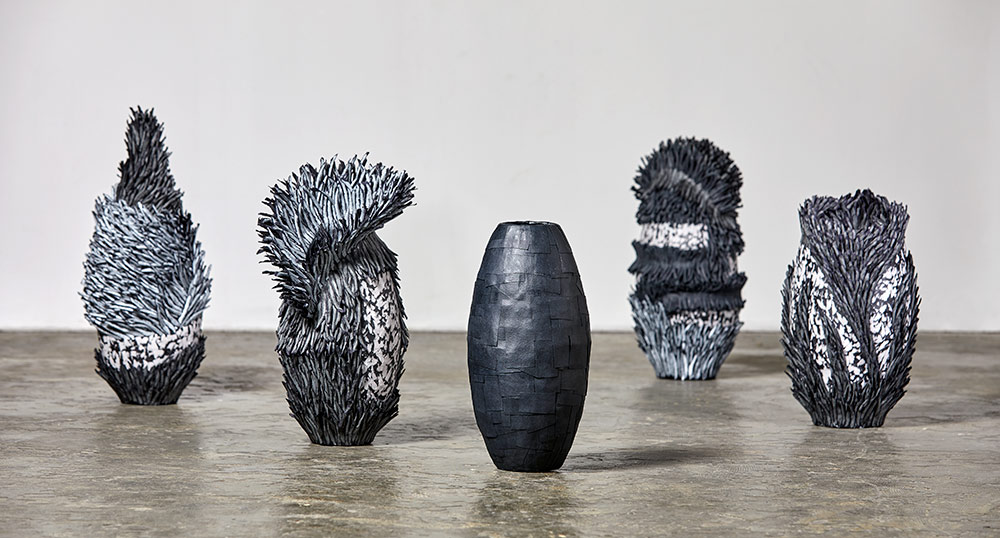
Technique: Hand-torn paper, acrylic, Konjac
Measurements: various heights from 53 cm till 42cm
© Bianca Severijns
“In My Hands And Between My Fingers”
“In my hands and between my fingers, paper feels like a superpower medium that enables me to convey my artistic vision with a mixture of seriousness with whimsy, abstract with concrete, the personal with the universal.”
– Bianca Severijns
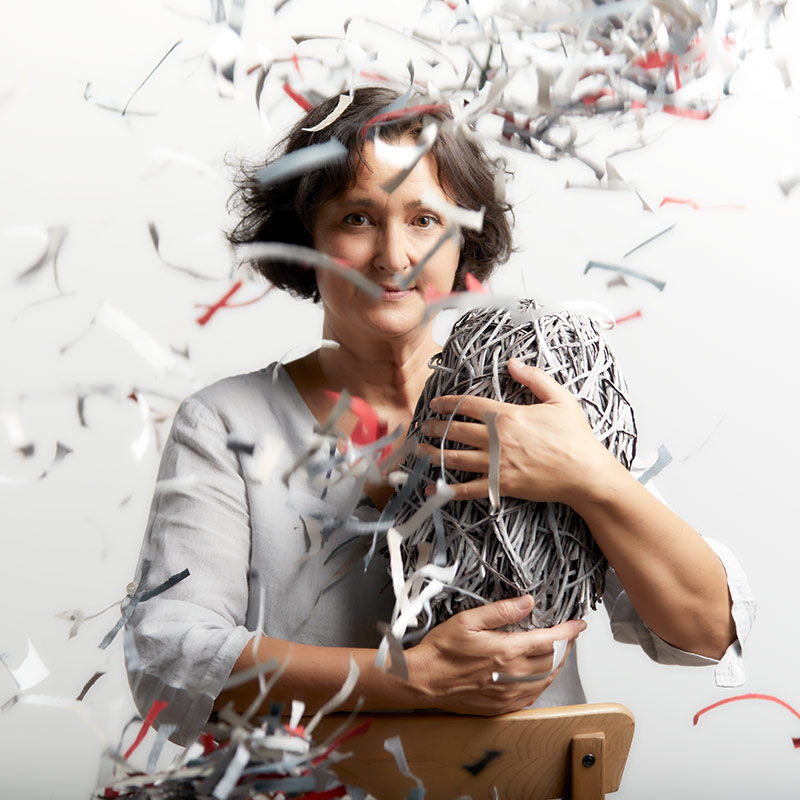
Photography by Sigal Kolton
Bianca Severijns is a contemporary artist who transforms paper into intricate, complex artworks that create a unique visual impact. Severijns is known for her original and distinguished paper language, with which she aesthetically arranges hundreds of hand-torn pieces of paper into sculpture tapestries, murals, and reliefs. Her works explore subjects of displacement, uprooting & re-rooting, and social themes.
Severijns was born in the Netherlands and currently works and lives in Israel. While it was her choice to uproot from the Netherlands, her experiences as a new immigrant in a new homeland were the inspirational foundations from which her paper artwork sprouted.
Her contemporary paper art journey began as a study of the cycles of nature and progressed to social and humanistic themes.
In her earlier pieces, Severijns sought to analyze the theme of displacement and how the stages of nature intertwine with human conditions such as forced uprooting, nesting, and revival.
As a quest for a deeper and more profound exploration of the displacement theme, she started to examine the fundamental basic needs of people who are displaced. Her recent artworks concentrate on a re-conceptualization of a humanitarian first need.
For the exhibition “Personal Structures – Identities” at the 2019 Venice Biennial, she created a wall installation of two large protective blankets and a video as a metaphor to convey fundamental human rights and needs of security, protection, acceptance, respect, freedom, etc.
All image courtesy: Sigal Kolton © All rights reserved.
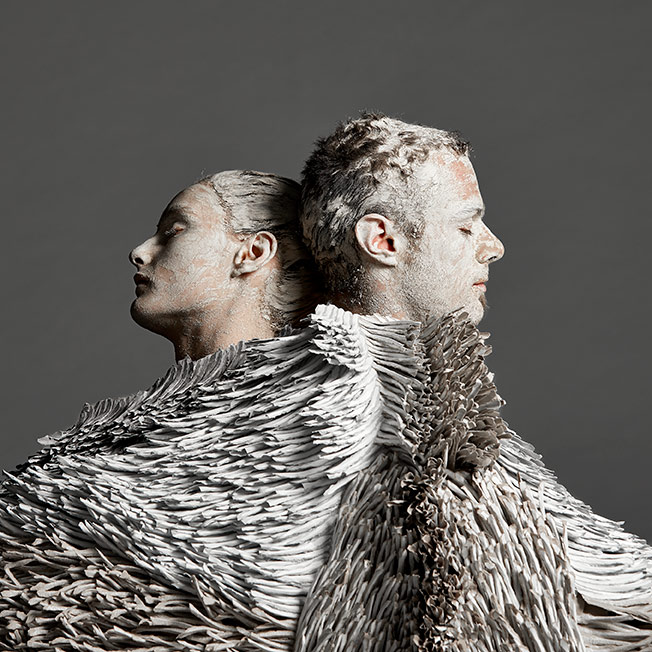
Hand-torn paper, konjac, acrylic, thread, textile
H200 x W145 x D10cm
© Bianca Severijns
Anastasia Tsypkina: Hello Bianca, it’s an honor to get to know you and your outstanding art!
Bianca Severijns: Hello Nastya, it is an honor to be featured in Art Market Magazine, thanks for this great opportunity!
A. T.: Considering the current situation of the lockdown world, I would like to start with a simple routine question: What’s the best way to start the day for Bianca Severjins, and how different has it been since the lockdown?
B. S.: I usually start my day by reading the Artsy Editorial online. I am very privileged that my studio is part of my house, so being confined does not stop me from working on my art. What has changed is that the pressure of deadlines is off, as most of the exhibitions are closed or postponed.
I suddenly have time to watch artists’ talks and find pleasure in live reports, for example, the Sydney Biennial and the curator’s talks of the Stedelijk Museum, Amsterdam, on Instagram.
Absurd, surreal worlds of empty museums entering my home make me realize how terribly I miss the culture, social life.
At a particular moment, my art supplies were running out, which forced me to do smaller works from paper leftovers. This resulted in a series of 12 mini works from 26 x 26cm. The slowness of the day also gives me headspace for planning new projects and developing new ideas.
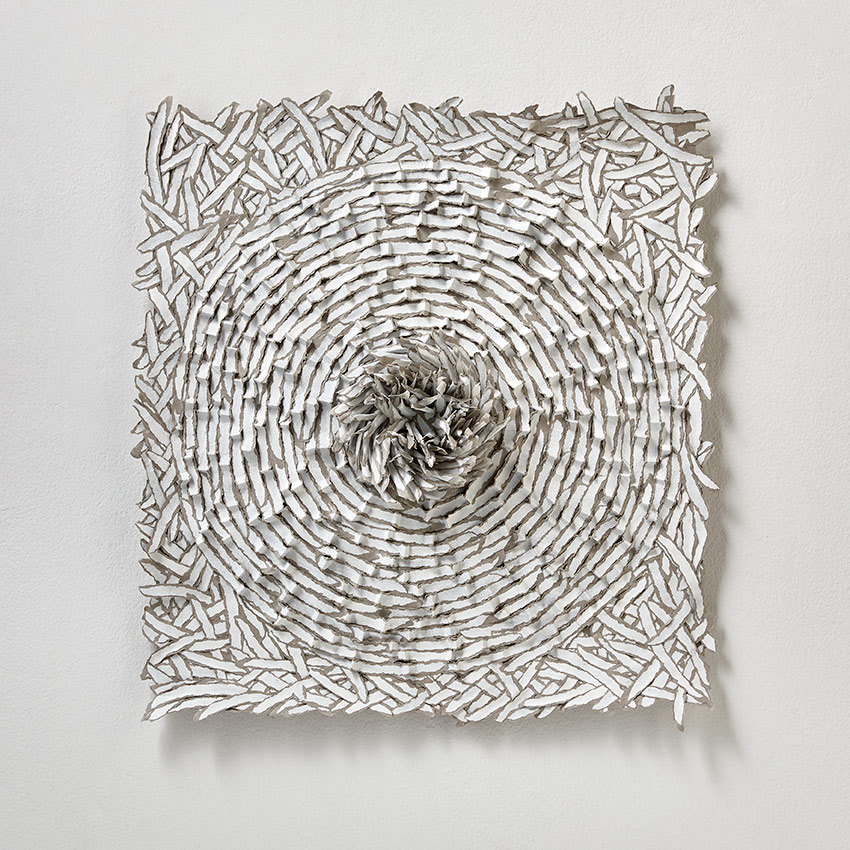
Hand-torn paper, konjac, acrylic
H38 x W35 x D5cm
© Bianca Severijns
A. T.: What do you consider to be the most complicated for the artists at this period? Will the situation with COVID-19 be somehow captured or reflected in your future works?
B. S.: I believe many artists find themselves in suspended times due to not being able to work in their studios or teach, suffering from exhibitions postponed or closed, shortage of art supplies, and managing financial struggles.
At the beginning of the year, I had a tight schedule of preparations for exhibitions planned in 2020 –
The Tel Aviv Biennial, Fresh Paint Contemporary Art Fair, several group exhibitions, and a solo exhibition at the Hansen House in Jerusalem.
Now it is all one big question mark… The entire world was turned upside-down by Covid-19. Everything is now “on hold.” I keep continually active in my studio regardless if anything will be on show this year.
For a planned group exhibition titled Confrontation – Conversation in Buenos Aires this coming October, I initially wanted to make a work dealing with “Femicide.”
Although the sudden harsh confrontation and its effects with this pandemic changed my course. I suggested three Covid-19 artworks that are a natural extension of the social themes and humanitarian subjects in my art. As I see it, the confrontation addresses our dealing with sudden disasters, while the conversation relates to how mankind can leverage catastrophes for positive change.
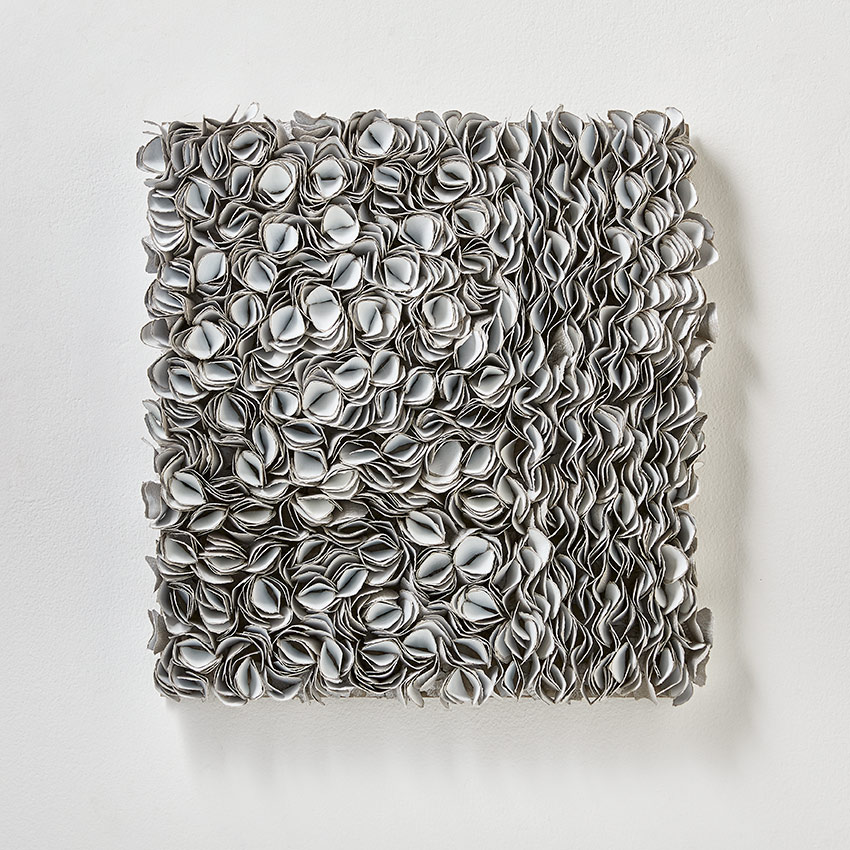
Hand-torn paper, konjac, acrylic
H38 x W35 x D5cm
© Bianca Severijns
A. T.: Your paper compositions are incredibly relevant, challenging, arise global problems as well as personal subconscious questions. How do you manage to work with materials more often being used just as a part of the painting and not as the main tool that can speak for itself? Which techniques do you use to turn paper into an art object?
B. S.: Rather than regarding the paper as merely a support to draw or paint on, I treat the paper as a material that can be manipulated in a new and unusual way. Paper is my treasured medium.
I approach a paper with my bare hands, which makes our relationship very intimate. Paper is vulnerable and humble while also decisive and powerful – perfect for conveying my artistic visions.
The material is full of possibilities and begs to be transformed: you can cut, fold, weave, tear, crumble, roll, paste, and layer it. Most of these techniques I use to create my artworks, although the tearing of paper is my absolute favorite. I am always attracted to the handmade.
My artworks are labor-intensive in that I tear each piece of paper by hand and then merge them into aesthetic compositions. Labor is a pleasure for me, from time to time, I find myself in a meditative state, totally engulfed, drawn inwards.
Still today, I discover new things, develop new techniques, and explore new paper-related elements. The play with paper is endless!
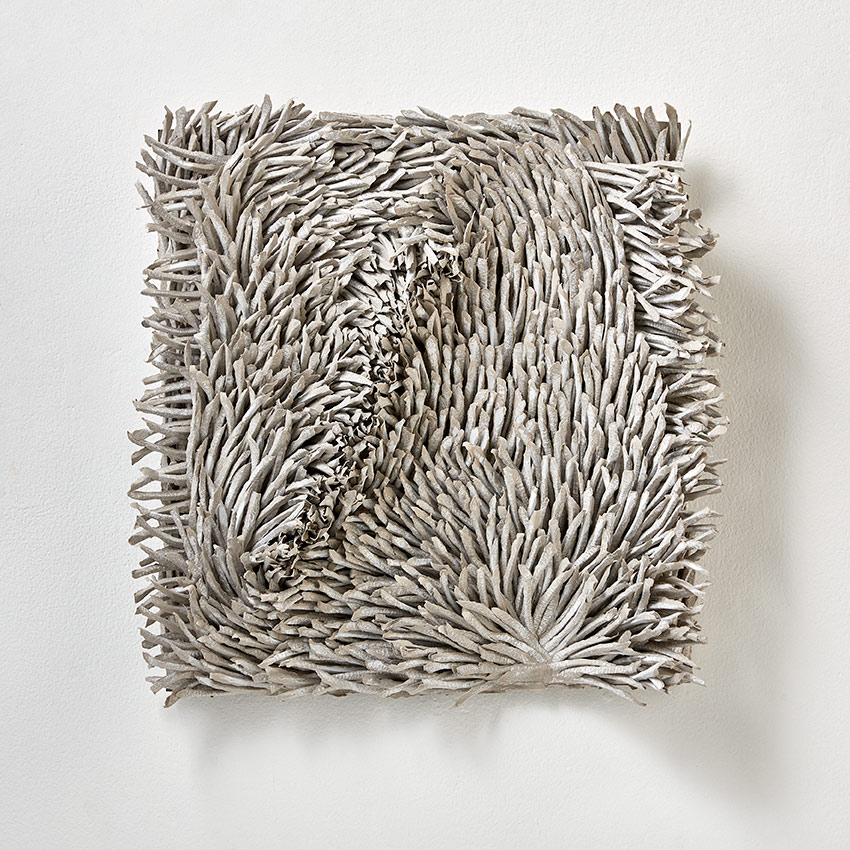
Hand-torn paper, konjac, acrylic
H38 x W35 x D5cm
© Bianca Severijns
A. T.: Tell us more about Venice Biennial in 2019. How was the idea of the “Protective Blanket” Series born?
B. S.: I was invited by the European Culture Centre (ECC) to participate in the Personal Structures exhibition during the Venice Biennial 2019. The objective was to place established artists next to emerging artists from all nationalities. I created a wall installation of two Protective Blankets and a video.
The idea of the Protective Blanket Series was born during my quest for a deeper and more profound exploration of the displacement theme. I started to examine the fundamental basic needs of people who are uprooted or displaced.
My search brought up many media images of aid organizations whose first action upon contact was to offer blankets.
Although often perceived as an ordinary object, a blanket is loaded with associations, connotations, and expectations. It holds the promise of care, warmth, and protection.
We are welcomed into the world in a blanket, and we leave it in blanket. In the lifetime in between, we need physical and metaphorical protective blankets for our personal existence and well-being.
My blankets are a metaphor for fundamental human rights and needs, such as security, protection, acceptance, respect, and freedom.
The experience of being part of the Venice Biennial 2019 was one grand art feast! From an artistic angle, the Biennale 2019 was a fantastic opportunity to promote dialogue on topics such as tolerance and appreciation.
Those of us who enjoy a degree of freedom, safety & fairness are lucky. The many paper threads that compose my Protective Blanket installation represent the emotional testimonies of people either needing protection or providing it somewhere in the world – it can be in our community or on another continent.
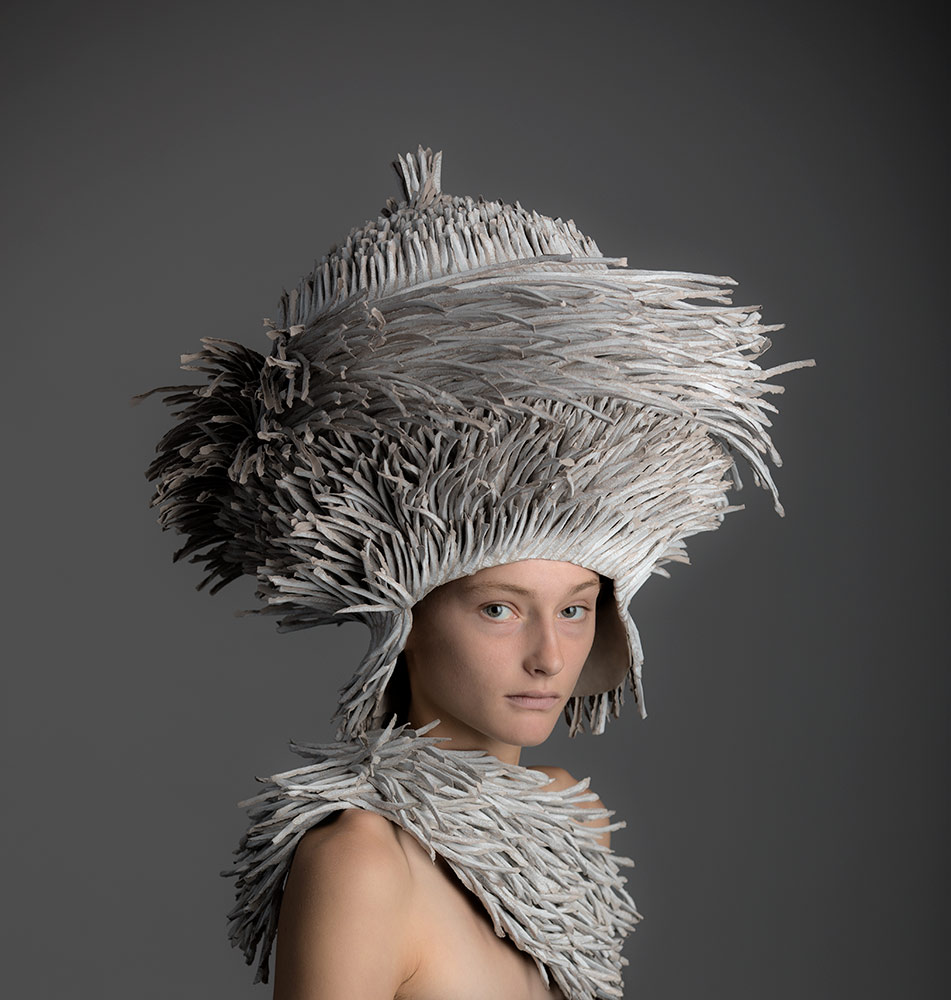
Hand-torn paper, acrylic, konjac
Measurements of head vessel:
H 53cm x W 53cm
© Bianca Severijns
A. T.: Is there something that unites the last two series of yours – “Movement and Rhythm Series” and “Earth Matters”? Do they convey some of the turning points of your life?
B. S.: In my process, I explore temporality, rhythm, and fluidity that you will find in both the “Movement & Rhythm” as well in the “Earth Matters” Series. However, the Movement & Rhythm Series I every year expand with new art reliefs. The intricate, organic repetition dominates these artworks inspired by the Dutch artist Jan Schoonhoven, who was a master of bare, minimalistic, timeless, abstract reliefs. “My mind gets captured by Schoonhoven when I miss Holland, and some of these works depict a clear visual affinity with his art and my birthplace.
In the Earth Matters Series, I accomplished only one artwork before the outbreak of the Covid-19 pandemic.
The project was encouraged by a planned group exhibition here in Israel. The works that will dramatize the painful results of climate denial that is manifested by neglecting to actively change personal habits, ignoring the need to alter lifestyles that harm the environment and underestimating the importance of making a collective effort to save our planet!
Nevertheless, our Covid-19 experience has made us aware of the rapid positive changes in nature due to no air traffic, total stand-still of manufacturing, less consumption, etc. This is an important lesson to reset our lifestyles for positive change and now is the right moment!
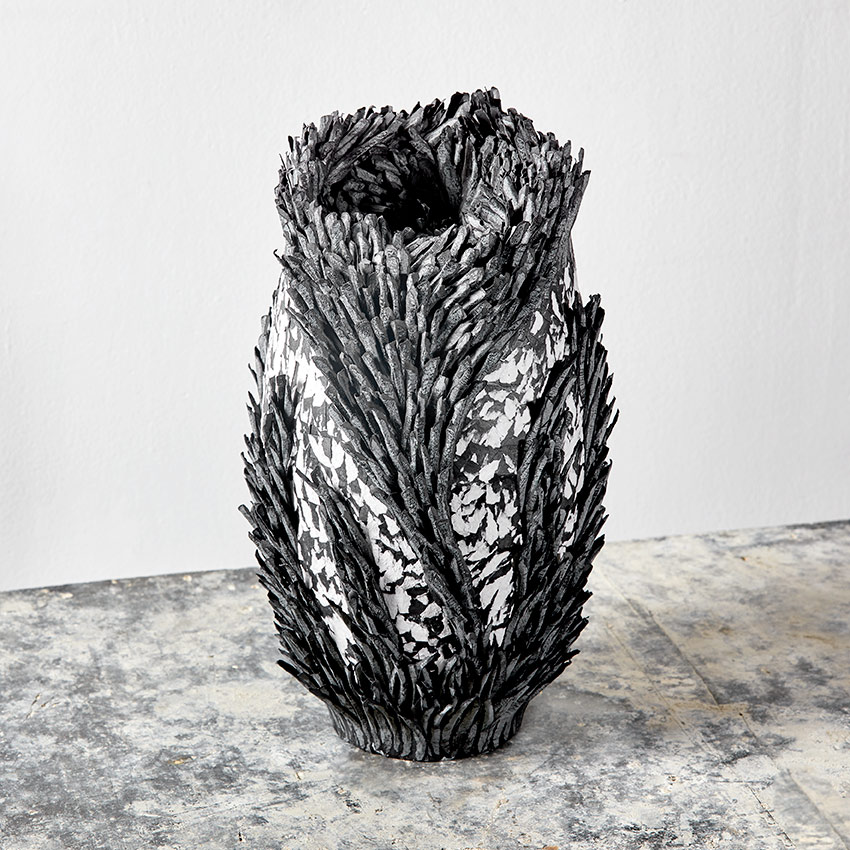
Technique: Hand-torn paper, acrylic, Konjac
Measurements: various heights from 53 cm till 42cm
© Bianca Severijns
A. T.: How’s life in Israel transformed your artistic views and personal values? Has been this immigration experience an inspirational one or a tough one for you? Or perhaps, both?
B. S.: I believe my personal values did not change; I just became more aware of certain values I appreciate because I am witnessing the complexity and absurdity of everyday life here in Israel on various levels: cultural, social, political, military, religious, etc. My experiences as a new immigrant were the inspirational foundations from which my paper artworks sprouted. It was a life-changing event, of course, both tough and inspirational. Coming from a so-called protective, safe, easy-going Netherlands, I was suddenly exposed to wars, terrorism, religious issues, a strong Middle Eastern mentality, and so on.
I uprooted myself by choice, but many in Israel (Jews, Muslims, Druze, Bedouins, etc.) were forced to uproot or have a family member that was forcefully uprooted. This subject intrigued me so much, it turned into the “Uprooted Series.”
I feel a strong correlation between my work process and this theme: my hand-tearing technique represents situations of being torn forcefully away from ties and belongings.
The monochromatic color neutralizes feelings and associations to homelands.
The time and labor invested in creating the art reflect the required time and labor for re-rooting in new soil.
A. T.: What are you most looking forward to in a contemporary art field in the next 2 years? And what new projects are you working through these days?
Read the full Interview Article on Art Market Magazine Issue #47

